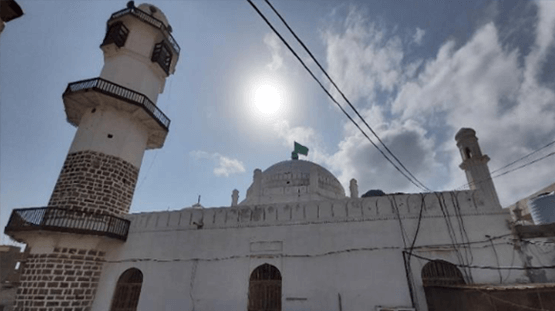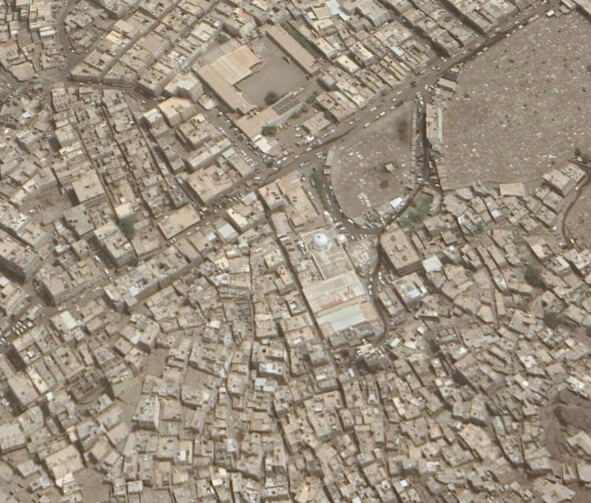
Al-‘Aydarūs Mosque – Aden
جامع العيدروس- عد ن
Monument description
Al-‘Aydarus Mosque is considered the oldest historical and archaeological monument, and holds a special place in the Adeni cultural heritage. The Mosque is still standing today with its original building modified by the first and second expansions. The Mosque contains the Dome of the Mausoleum in which some prominent scholars are laid to rest. It also serves as a religious school, from which a group of distinguished scholars have graduated over the course of five centuries. This mosque has a special place in the hearts of the people of Aden in particular, and the people of the country in general. On the 12th of Rabi` al-Thani every year pilgrims come to celebrate the so-called ‘visit of the ‘Aydarus’.

Architectural and cultural value
Construction style and built date: The Mosque is built on rocky land that slopes slightly towards the north and northeast, and the solar (volcanic) stone was used as the main building material, as well as the use of wood in the columns and roof of the old Mosque. Al-‘Aydarus Mosque is one of the oldest mosques in Aden. It was constructed in 899 AH, when Imam Abu Bakr built its first settlement in Aden. Its architecture was renewed more than once during the 11th and 12th centuries AH, the last of which was in the middle of the 13th century, by Ismael bin Habib Al-Maimani, who was a well-known man in Bombay (India). The Mosque has also been extended by two modern additions in the last century.
Components of the Mosque: The current Mosque consists – on the northeastern side – of an area that includes the old Mosque, the Minaret and the Mausoleum dome, surrounded by a corridor on three sides. The two successive expansions of the Mosque occurred on the south. To the northwestern side of the Mosque there is a Meda’a, a water well, then a water basin called the well of Al-Shifa, in addition to a group of rooms, some of which are used as warehouses and others for managing the Mosque. The modern Ribat extends on one floor above the two Mosque expansions.
- Justifications for intervention:
- 1. An urgent intervention is needed to restore and maintain the Mosque, which is more
than five centuries old, due to its historical, social and spiritual importance to the people of the region. Removing the reinforced concrete that was introduced by the Bin Laden Company in the 1990s on the ceiling of the old mosque to suspend the wooden ceiling.
2. Rebuilding of the wooden roof in the traditional way, with the timber having the same specifications as the old timber.
3. Treating the damages sustained by the Mosque by modern scientific methods, such as using crack repair materials (epoxy) for the roof of the old Mosque and the roof of the Mausoleum dome to preserve the inscriptions on the inner side of the dome.
- Monument conditions and treatment:
- The monument presents many damages, including: The monument presents many damages, including:
1. Spread of humidity in the walls and damage to the plaster cladding layer, with the spread of salt content due to the proximity to the coastal areaTreatment: Removing the damaged cladding, revealing the stone wall layer, and reapplying the cladding layer with traditional materials, with the final smoothing done with soft pumice and Noura. Widening of cracks and filling with coarse pumice followed by soft pumice and Noura.
2. The use of oil-based paint over the years led to the disappearance of many Quranic verses engraved on the main entrance. Damage to the plaster inscription in the upper arch of the main entrance DomeTreatment: Use modern chemical material to remove layers of oil paint from the main beams of the entrance to restore the Quranic verses. Removal of areas of damage from plaster inscriptions to restore them with traditional materials and repaint with watercolors.
3. A concrete ceiling was built for the old Mosque to hang the wooden ceiling, and there are no construction drawings showing the process of its construction. The cracks on this ceiling are clear and lead to the leakage of rainwater. We were not able to photograph these cracks because the people in charge of the Mosque periodically cover them with cement and Noura. Treatment: Either maintaining the new concrete ceiling and using modern materials such as epoxy to repair cracks and stop the leakage of rain water as an emergency solution, or removing the entire concrete ceiling and rebuilding the columns and wooden ceilings by importing timber of the same quality and rebuilding the ceilings in the traditional way.
4. The spread of termites in wooden columns and ceilings as a result of seasonal rainwater leakage, in addition to its age, which exceeded nearly five hundred years. It was noticed that the wooden columns were damaged greatly, and the people in charge of the mosque used white cement and plaster to fill the places of damage and cover them with oil paint
Treatment: Restoration of wooden columns and ceilings in the traditional way and using iron beams before starting work, taking into account the need to import of timber with the same specifications as the old timber, which has stood for nearly five hundred years.
5. Cracks in the Mausoleum Dome Treatment: The cracks in the dome of theMausoleum must be treated using modern special materials to fill the cracks to ensure that rainwater does not leak. Treatment: Treating the plaster inscriptions in the Dome of the Mausoleum from the inside with traditional materials, taking into account the use of water- based paint for the parts that will be restored and the entire interior renovation the Dome inscriptions with the original colors.
Urgent interventionReinforcing the ceiling and walls of the dome of the Mausoleum.

Countries












